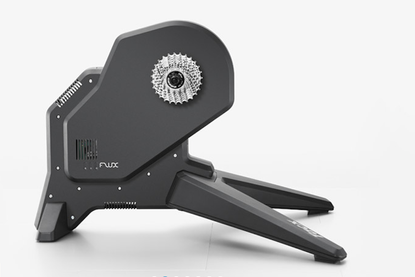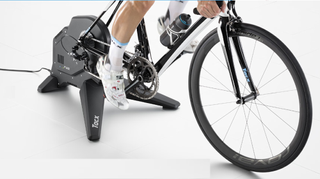Tacx Flux Smart turbo trainer review
Tacx’s latest addition to the direct drive trainer category brings most of the features of its range topping big brother, the Neo, at a more wallet friendly price.

For the rider wanting a more simplified introduction to the world of direct drive trainers, the Flux is the perfect choice. Out of the box the simple set up and easy to use smartphone app enable simple control of the smooth, powered resistance unit. Interactivity and realistic resistance changes with third party software such as Zwift really allow the Flux to shine.
-
+
Realistic ride feel
-
+
Very stable and quiet
-
+
Simple connectivity with third party devices/software
- +
-
-
Non-folding design
-
-
Needs external power
You can trust Cycling Weekly.

The Tacx Flux Smart is the second in a duet of direct drive trainers from Tacx. Following on from the all-singing Tacx Neo Smart, the indoor trainer giant has managed to package up the benefits of direct drive into a very competitively priced trainer.
>>> Best Black Friday 2018 Cycling deals
Out of the box the Tacx Flux Smart needed minimal assembly; just slot the stabilising legs into the main body and bolt in place. Unlike the Neo however, the Flux doesn’t have the convenience of being able to fold away for storage. Ideally it is suited to a dedicated training room or space, as once it is built the sheer weight and bulk makes it difficult to practically move regularly.
Further compounding the immovability is the lack of a carry handle or even basic hand holds, making carrying awkward. Something I feel Tacx has forgotten, as main rival Wahoo has included one on its excellent Kickr turbo trainer. Fortunately for any non-cycling members of the household, the Flux is relatively discreet and good looking (for a turbo trainer), so shouldn’t encroach too much within a multi-purpose room.
Tacx has fitted the Flux with Edco’s MultiSys freehub body, allowing Shimano, SRAM and Campagnolo cassettes to be fitted to the same unit. This also means that if you are a serious high mileage indoor rider, spare bodies can be relatively easy to source. Edco also uses decent sealed bearings for reliable performance. Spacers for fitting 9 and 10-speed cassettes are supplied along with multiple lockring options.
At this moment the Tacx Flux Smart is only configured for use with standard quick release (so not thru-axle) frame configurations. Tacx supplies spacers to allow 135mm (MTB/CX) axle spacing as well as standard 130mm road axle fitment.
Watch: Buyer's guide to turbo trainers
Like the majority of Smart trainers, the Tacx Flux Smart relies on electromagnets to adjust resistance. This means that a power source needs to be available to run the unit properly.
The Flux is capable of delivering up to 1500 watts of resistance for sprint sessions and can consistently hold up to 850 watts for a minute and up to 450 watts for a 20 minute period. Whilst these figures are lower than the stated capabilities of the more expensive Neo, they are more than sufficient to cover the requirements of all but the most powerful riders out there.
>>> Should you buy a smart turbo trainer?
To start accessing the features of the Flux, the minimum that is required is the Tacx Training app. Through your smartphone and via Bluetooth you are able to record training sessions and manually control Slope and Power settings. Compatible heart rate straps can also connected.
>>> Zwift vs Peloton: which is best for your at-home workouts?
The only downside to the app is workouts cannot be synced directly to Training Peaks or Strava. If this is important to you, the Flux can be connected to a Garmin or other ANT+/Bluetooth headunit to store data.
But it is pedalling where the Flux really shows the benefits of direct drive turbos and why they are becoming the future of indoor training. Resistance is consistently delivered and feels silky smooth through the pedals. In comparison to a wheel driven trainer, powerful starting efforts rarely feel like they are overloading the motor and the feedback is instantaneous.
>>> Turbo trainers: a complete buyer's guide (video)
Adjusting power manually results in noticeable increases in resistance that read similarly to measurements recorded using different power meters. The figures were always within the +/- 5% stated by Tacx, albeit a little low on most occasions.
The Tacx Flux Smart can be adjusted to apply resistances equal to a 10% climb which is good for most hill training but lacks the 25% capability of the Neo for true mountain goat wannabees. It doesn’t feel quite so natural and ‘bike-like’ as the Neo or Wahoo Kickr due to the lack of motor driven freewheeling capability, but is certainly better than most high end wheel driven trainers.

As with most other direct drive trainers, the Flux produces very minimal noise, even during sustained hard efforts. Testing this by setting it up in a bedroom produced a noise no more disruptive than a dishwasher heard through several closed doors.
For more involved training, Tacx has enabled the Flux to be compatible not only with its own proprietary training software but also with third party software such as Trainer Road and Zwift. Whilst all require more monetary outlay, the ability to create a more immersive VR style experience adds an immense positive to what can be a very mind-numbing experience.
>>> Zwift: everything you need to know
Tacx has a huge range of Real Life and computer generated courses enabling real-time riding experiences of some of the most iconic climbs and races of the world. All of which allow the Flux to adjust resistance according to the situation. Zwift and the more ‘serious’ Trainer Road can be utilised properly, although the occasional resistance lag can be detected on very rolling courses or rapidly changing interval settings.
The only thing to note about the Flux (and direct drive trainers in general) is full-on, out of the saddle sprints can sometimes feel like they are placing additional stresses onto your bike frame. Also, if you wrench on the bars a lot, make sure the quick release is done up tightly!
>>> Turbo training sessions: get the most out of your indoor training
Overall, Tacx has created a highly competitive entry to the direct drive market with the Flux. Whilst it doesn’t offer the same life-like feel as the Neo, or the same levels of resistance – at £500 cheaper this is something you could live with. As a trainer, the Flux makes following and completing specific workouts and training plans much simpler. For experiencing the proper feel of Tacx’s own VR videos and software and for Zwift users the Flux Smart is an excellent choice, helping minimise the inevitable lack of motivation during indoor training.

Thank you for reading 20 articles this month* Join now for unlimited access
Enjoy your first month for just £1 / $1 / €1
*Read 5 free articles per month without a subscription

Join now for unlimited access
Try first month for just £1 / $1 / €1
Get The Leadout Newsletter
The latest race content, interviews, features, reviews and expert buying guides, direct to your inbox!
James Bracey's career has seen him move from geography teacher, to MBR writer, to Cycling Weekly's senior tech writer and video presenter. He possesses an in-depth knowledge of bicycle mechanics, as well as bike fit and coaching qualifications. Bracey enjoys all manner of cycling, from road to gravel and mountain biking.
-
 I don’t drink alcohol - Is there room for non-drinkers in cycling culture?
I don’t drink alcohol - Is there room for non-drinkers in cycling culture?Rethinking cycling’s drinking culture to focus on connection, inclusivity and post-ride joy for everyone
By Marley Blonsky Published
-
 My cycling new year’s resolution? No more distance targets
My cycling new year’s resolution? No more distance targetsI’m going to try and enjoy cycling for its own sake, and to keep fit, without aiming for a round number
By Adam Becket Published
-
 Tom Pidcock among 12 cyclists recognised in New Year's Honours list
Tom Pidcock among 12 cyclists recognised in New Year's Honours list10 Olympic and Paralympic riders honoured in yearly list, including women's sprint trio of Emma Finucane, Sophie Capewell and Katy Marchant
By Adam Becket Last updated